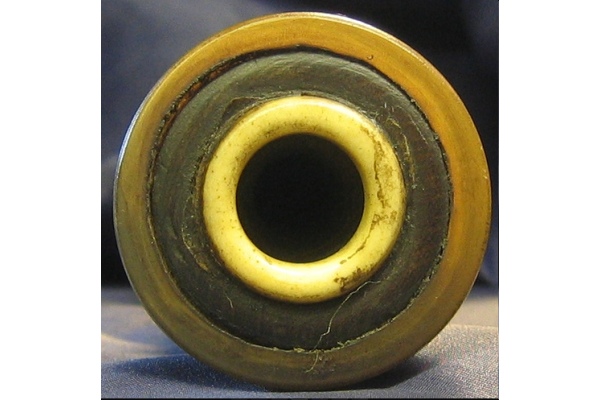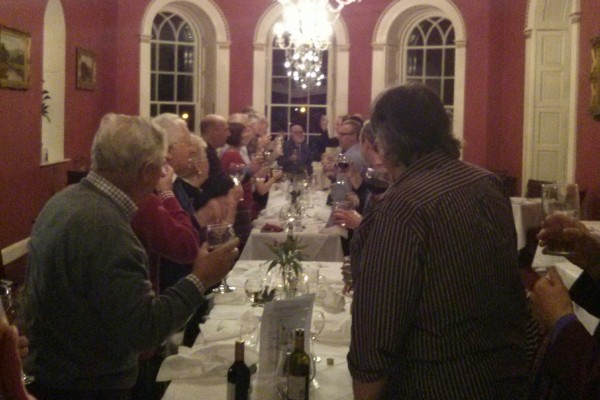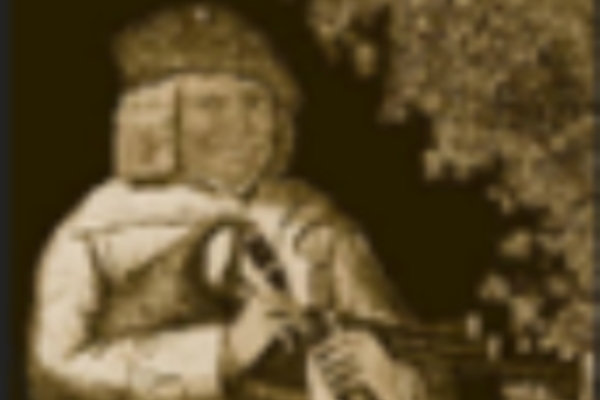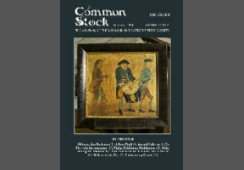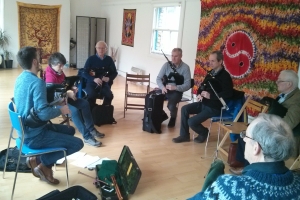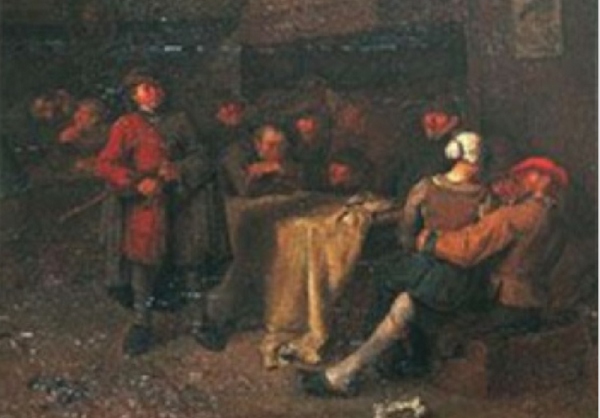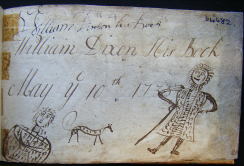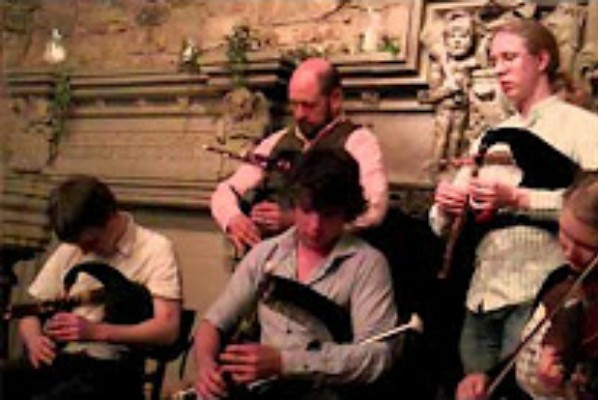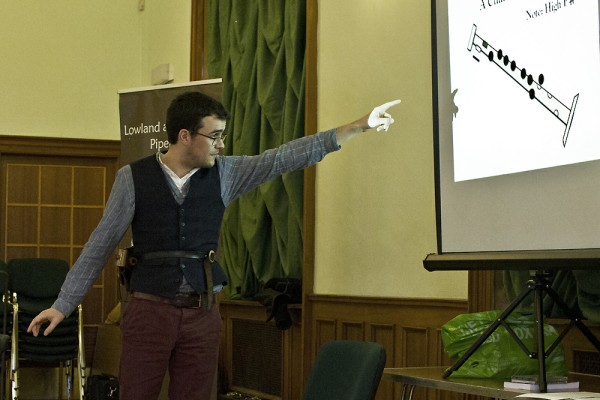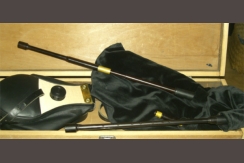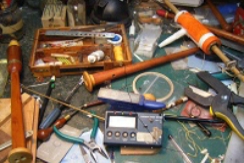Matt Seattle addresses a neglected Border Piping Tradition
“7. George Syme, was supposed to have been born and bred in one of the
Lothians. He was the best piper of his time; he knew the art of producing the high octave by pinching the back hole of the chanter, which was reckoned a great improvement. He was the best piper of his day. He lived about the middle of the eighteenth century.” – Thomas Scott, 1816
It’s a testament to Gordon Mooney’s vision that he chose John Kay’s cartoon of Geordie to grace the cover of his pioneering collections of the 1980s, and it’s entirely fitting that it is also the logo of the Lowland & Border Pipers’ Society.
It’s unusual, however, to hear of pipers who aim to follow Geordie’s example in enlarging the scale by a couple of notes. This should be mainstream Lowland and Border technique by now: compare the way Gordon Duncan showed how modern Highland piping can be enhanced with chromatics outwith the 9-note scale.
Let’s look at a tune. The Highlandman Kiss’d his Mother appears in a few Highland pipe collections including David Glen’s, Book 9,

There’s a naïve innocence to Glen’s setting. If a fiddler were to play from this score (ignoring the articulation marks) she or he would be playing the tune in C major and A minor, just as it was meant to sound: it has a long history as a fiddle reel before being taken up by pipers. When played by Highland pipers the tune sounds in mixolydian mode throughout rather than the fluctuating modality of the original. If we play it on our pipes as actually written above, with c naturals and f naturals, we go a little way to curing the problem, but with drones in A we’re missing the tune’s essential modal contrast. It’s better to transpose it up a tone,to D major and B minor:

This arrangement, a tone higher than the fiddle version, and with two original strains, has high b in bar 4 of each strain. It was some years before I even thought to try to play high b on the custom-made chanter that Nigel Richard made for me in 1995 to fit my “Jacobite” drones but, living in the toon of the Soor Plums in the early 2000s I had to give it a go, and it has become more reliable the more I’ve played it. I’m by no means alone in this, but I’m still one of a fairly small number of players who do it on a Border pipe chanter as distinct from the French-influenced “English” Border pipes – or the pyrotechnics of the Lindsay system! Some Scottish smallpipe makers add a high b key to their chanters, a useful feature for a piper who wishes to play tunes outwith the 9-note repertoire. As for Border pipes, Jon Swayne writes:
“The answer to your question really is that it depends on the reed. If you voice the reed to be loud and super stable, high b is less likely. A softer reed makes high b easier and sometimes you can get a c.”
In the early days of the revival there was great enthusiasm for reviving the old music, but not so much for rediscovering the techniques required to play it. After Gordon Duncan, no-one raises an eyebrow over c and f naturals, but two and half centuries after Geordie Syme, how many of us play tunes with high b and c#? If we don’t, is it because we don’t wish to, we don’t know how to, or our instruments just won’t go there? The LBPS is often described as a “broad church”. It would be even broader if it contained a few more believers!
Notes on the tune:
1. It appeared in English Dancing Masters before its publication in Scotland by
Robert Bremner (c. 1750).
2. In the original key some versions have f# rather than f natural (corresponding to g# rather than g natural on Scottish chanters); the 2nd and 3rd notes of bars 1 and 3 are tied in some versions; and the semiquaver run does not feature in many versions.
3. The tune has several other titles, including Jackie Stewart’s [New] Reel, The Jolly Seven, Miss Kelly’s, and Ryan’s Reel, and has also been published in Irish and American collections.
4. The “Jacobite” Border pipes in Morpeth Chantry Bagpipe Museum are on the less beefy end of the spectrum.
As a supplement to Matt’s article here are some source quotes for right-hand thumb techniques to accompany the description of Geordie Syme he quotes :
Walter Scott, Redgauntlet (Edinburgh, 1824): “There dwelt my gudesire Steenie Steenson [he] could play weel on the pipes; he was famous at ‘Hoopers and Girders’ - a’ Cumberland couldna touch him at ‘Jackie Latin’ and he had the finest finger for the back-lill between Berwick and Carlisle.”
Sir William Brockie, The Gypsies of Yetholm (Kelso, 1884): “Early in his teens James had begun to tackle the small bagpipes, in the playing of which his father had attained great proficiency and who boasted that none could approach him in the difficult art of "shivering the back lill", the highest note on the bagpipe, which is performed by a peculiar trill with the thumb, and which affords an opportunity of showing the players mastery over the instrument and of attracting notice and applause from the audience.
Robert Barclay, Reminiscences of an Unlettered Man (1850-1924: published 1985) “My father played the bagpipe, a half-size set supplied with wind from a bellows worked by an arm [and] by what he called ‘pinching’ extended the range a few notes, by half-opening the back hole with his thumb nail.”
(See the article ‘Administering the Drones’ in our March 1990 issue)
The Sutherland Manuscript (in the Mitchell Library, Glasgow <1785): it has
mostly pastoral pipe music plus three scales, one of which “The Scale for the Highland Pipes” shows two second-octave notes with pinched thumbholes.” (from Ross Anderson’s website
https://www.cl.cam.ac.uk/~rja14/Papers/Sutherland-Manuscript.pdf).
There is also the hard evidence of worn or grooved thumbholes in a number of early pipes in museums including the set which may well be the one presented to Peebles (and its Town Piper James Ritchie) in 1776 by a grateful Member of Parliament, which has a groove made presumably by a piper’s thumbnail. The pipes are now in the National Piping Centre in Glasgow
